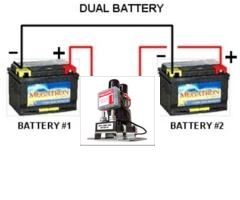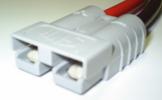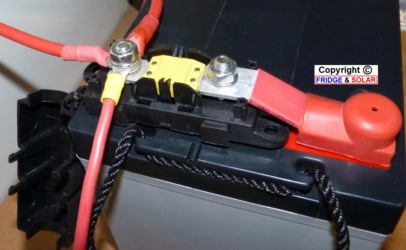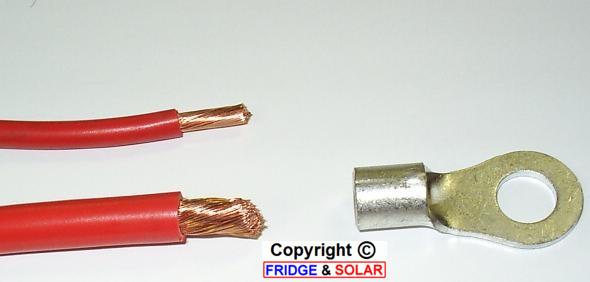**July 2022 Update, warning, generally you should not use a VSR as described in this article below,
if
you have a vehicle fitted with a smart alternator, the risk is that
your auxiliary battery may not be charged correctly or efficiently!
Also when charging lithium LifePo4 batteries a VSR should not be used, the risk is grossly over or under charging.
In both cases it is best to use a modern DC- to - DC battery charger, with a charging profile suitable for your battery type!
Auxiliary
Batteries are used to operate appliances while you are away
from mains 240v power,
and also so you don’t run the risk of compromising you
vehicles main starting battery
(I'm sure that you agree that
jump or push starting your vehicle is not much fun and best
avoided.) 
People have been using and charging
auxiliary batteries in their cars and caravans with varying degrees of
success for over a century.
For most of us the days are long gone when all we needed from our
auxiliary battery was a small amount of power for a bit of lighting and
maybe a radio.
These days we expect much more, we
like to run lights, TV’s, Laptops, DVD’s, pumps,
fridges, winches, and charge camera batteries and mobile phones etc,
some even run microwaves, it is true that some of us like all the
luxuries of home when we go ‘camping’.
So over the years our demands on the
humble auxiliary battery have increased to the point that we need much
more usable energy, and over a longer period of time, and we need fast
and safe ways to recharge our batteries.
Many of the old ways used to charge
these batteries are now antiquated, and they mostly never did the job
very well anyway, neither were they conducive to long battery life.
So lets look at what we need to build
a system that will deliver the best performance for our hard earned
dollars.
Please
note,
While this is not a comprehensive step by step guide to installing a
dual battery system, it should however give
you a very good insight as to what is really needed, and why, and how
to go about sizing and fitting it all up.
What’s
needed.
Well I guess a good place to start
would be an auxiliary battery, then we need an efficient way of
charging this battery using the cars alternator, and most importantly,
a way of isolating the auxiliary battery from
your starting battery, so that your starting battery is not
compromised, and so you will always be able to start you vehicle and
not be left stranded.
To do this we use what is called a battery isolator, and then we need
some cable to connect it all up, simple eh, well it is simple as long
as you use the right bits, and put it together the right
way……
Auxiliary
Batteries.
Basically you should be thinking
about how big a battery can you fit, and less about how small and cheap
a battery you can get away with, now I know money does not grow on
trees, however the larger the battery the less percentage wise you will
be draining it each day, and the longer it will last for you, both in
power usage (battery capacity), and in battery life (longevity), with
the extra advantage of some extra capacity available to you if needed.
Hot Tip …Batteries LOVE being fully charged, they do NOT (never) much like being discharged at
all, they do LIKE it when you only take them down to about 50% of
their capacity, and then top them back up soon as you can (within a day
or so).
Batteries will lose capacity if left discharged, and they will die quickly if left discharged for
long lengths of time.
Deciding on what size and type of
Auxiliary Batteries to use is really a whole other story, please read
my article on AGM (Absorbed Glass Matt) batteries >>Please
click here for my article on AGM batteries<<
The
Battery Isolator.
The battery isolator is a device that
allows the cars alternator to recharge the auxiliary battery while
protecting the cars starting battery from discharging, if these
batteries are simply linked together you run the very real risk of
draining them both to a level that you can not start the engine, and
there are many other reasons why you should not do it this way.
So hence we have the battery
isolator, there are many different methods used to isolate the
batteries, most use some form of solenoid, this is an electronic switch
that can handle large (charging) currents, much more than standard
switches can, and they are operated by applying a small amount of power
to them, this is turn actuates a solenoid that links the batteries
together so that large currents and be passed between the batteries.
There
are many ways to operate these battery isolators, some much better that
others.
The cheapest way is that you manually turn them on
and off, I call these idiot switches,
because sooner or later some idiot (and I've been there) will forget to
turn the switch on (no charge goes into the auxiliary battery)
or off at the right time (and then the starting battery gets drained as
well). Another way of doing it is
to have the
solenoid turn on as soon as you start the engine up, and turn off when
you shut down the engine, this has been the cheap way of
doing it for many years, but it’s far from ideal and does
have a few pitfalls. I
believe the best way for most situations is to use a VSR (Voltage Sensitive Relay)
activated solenoid, and I explain a little further on how they work and
why I think they are so good. Now for
years I had used the Redarc Smart Start VSR with great success, and I've sold hundreds of them, they
really are a good unit.
However
a while ago after doing more
research and testing I came across another VSR that I found I
liked even better, with many great features, and I've listed some of
them below in my explanation of how it works.
This one I like the best
and now use is
also one of the least expensive ones, and it does the job very
well, truly ultra reliable (has been used in the boating/marine
industry for many years), and I believe these are as good as, and often
better than many of the much more expensive VSR's.
PS, I have now sold
over 1,800 of these Enerdrive ones and my customers are loving them :-)
So my choice now is the Enerdrive VSR battery isolator, I explain
how it works
and other info >>please
click
here<<
However if you want to know all the info on the Redarc Smart Start VSR
please read on.
The Redarc Smart
Start
VSR (Voltage Sensitive
Relay)
battery isolator.

When
you start your engine the Redarc works by first letting your starter
battery recover it’s charge, it lets it achieve 13.2 volts,
at this point that battery has about as much charge in it as it's going
to get, once the Redarc sees this 13.2 volts it closes the contacts on
the solenoid, this links both batteries together for charging purposes.
The
next thing the Redarc is looking for is 12.7 volts, in other words you
have shut down your engine and started to draw power from the
batteries, so very quickly the voltage across both batteries will fall
to 12.7 volts, as soon as the Redarc sees this voltage it will open the
solenoid contacts and isolate the batteries, leaving your starting
battery for starting and your auxiliary battery for auxiliarying ;-)
The Redarc
Smart Start
battery isolator is rated at 100Amps constant duty with a surge
capacity of 400Amps, it has silver contacts unlike some of the cheaper
ones that have copper (silver is much better), the Redarc also has
spike protection so it won’t upset the delicate electronics
on newer vehicles.
However
if you don't already have a Redarc VSR, and would like to learn about
an alternative that is now my favorite, and less expensive, then
please >>click here
for my full thoughts on the Enerdrive VSR and Dual Battery
Systems<<
Connecting up the Redarc Smart Start
The Wiring
& Cabling. Wiring…this
is without doubt where many people get it wrong and end up with a
system that may work, BUT barely, and nowhere
near as well
as it could
and should,
doing it right can double
the usable
capacity of your auxiliary
batteries over and above what many people normally have, and help them
charge much faster and last longer too.
Understand
that when charging from vehicle alternator one of your biggest enemies
is voltage drop, you need to have the highest possible voltage at the
auxiliary battery, this will allow it to charge as quickly as possible,
and as fully as possible. Some
standard
set-ups I see regularly that
have been fitted by the so called professionals is where they use twin
6mm auto cable (really 4.59mm²), this is next to useless for fast, deep
charging. A
very basic explanation would be, that the larger the current draw, the
larger the wire (cable) needs to be, and the further the distance the
wire needs to run, the increasingly larger
again the wire needs to be. Water
and power analogies work well here, so think about it, if you want to
fill a bucket full of water fast, do you use a hose the size of a
straw, or a ½ inch garden hose, what one do you think will
fill the bucket quicker?
I always suggest a minimum,
yes I did say a minimum of
6 B&S (13.5mm²) cable for linking batteries, larger is
even
better, any further improvements to the charging time, and system as a
whole, will be gained by increasing the size of this cable, I know that
the larger cable is not cheap, but bigger is always best in the long
run. Check out the photo near the bottom of this article showing the
difference between 6mm auto cable I mentioned before and the 6
B&S
cable that I recommend as a minimum!
Fusing & Cable
Protection!
 
Putting
fuses in is necessary because of the potential of a short circuit, now
seeing as we are installing good heavy cable so that we can transfer
large amounts of current quickly, there is a possible downside
......................
Now these good sized cables when short circuited to say the vehicle
body, or between them selves either by chafing through, getting hooked
by a stick, or heaven forbid, an accident, are capable of producing huge
amounts of flame and
spark (and I mean huge), and this is why we must
install fuses to
protect the cabling, the vehicle, and us!
I here we use 100A fuses, these are purely to protect the cable, or
more correctly, as I have just said, to protect you and your vehicle, from the cable,
and we need
two of them, one at each battery, because each battery
will be
connected to the same cable, even some auto sparkies can't get their
heads
around this, as they are so used to having only one supply source for
the power, not two!
After
having a few
failures sometime back using the 100A Maxi fuses (they were melting, not
blowing, melting because of high
resistance, this
created heat with the high currents),
so after doing a lot of
testing I found that the MEGA fuse performed best in this situation,
the MEGA fuse has been used for many years when connecting Inverters to
batteries.
Have a look at the photo of a MEGA fuse in it's holder near the bottom
of this article, another good thing about this fuse and it's holder is
you can use it as a power stud, and have all of your positive cable
connections coming off one side of the fuse, with just a single link
between the fuse and the battery, it helps make for a much easer,
simpler, and neater job. Tip,
often I mount these fuses right on top of the battery using a piece of
copper tubing flattened out with the holes drilled in it, really neat,
and a photo down there of this also 
The
MEGA fuse was considered expensive, however I imported these in bulk
from the UK, and I used to pass on the savings to my customers so that
they could take advantage of these very good quality fuses, at a very
good price.
I have now semi-retired and no longer sell these fuses, or the VSR's,
or anything really, but because of the good pricing that I introduced
all those years ago, now many others on eBay also sell them at good
prices.
Battery
placement.
A
very important thing to consider is where you are going to place your
batteries, standard open wet cell batteries give off hydrogen gas when
they are charging and discharging, this is a
very explosive gas, remember the
Hindenburg, there is no problem if you are putting the auxiliary
battery under the bonnet of your vehicle, or mounting it somewhere on
the chassis with good ventilation to the open air.
Just
throwing them under a seat or in a cupboard is far from ideal and just
down right dangerous, even worse some people place battery chargers and
even inverters next to these batteries, just think about that for a
moment, a hydrogen producing device next to a possible spark producing
device, I guess some people just don't know or don’t think!
Wet
cell batteries must be housed in a
properly vented area, and
must be well vented externally away from any ignition source and from
human habitat areas, hydrogen gas rises so sealed battery enclosures
should be vented externally top and bottom.
If
you need to place batteries inside vehicles, then AGM batteries should
be seriously considered here as they are totally
sealed, AGM batteries if placed in an enclosure only need to be vented
to atmosphere not necessarily vented externally.
Putting
AGM batteries under the car bonnet is fine as far as safety goes, the
only consideration here is that AGM’s and any fully sealed
batteries
should be kept away from the extreme temperatures of turbochargers, and
if they must be placed close to the turbocharger, then heat shields
should be used. How
to wire the Redarc up.
Now
this is much simpler than most people think, it is not complex, and as
long as you take care almost anyone can do it.
Safety
Tip
*
Do not install the Mega fuses until the last
thing, when you have completely finished all the cable runs and
tightened up all other connections first.
Note: *
Some people can use the chassis for earth
return, but my advice is to always (and
it really is best) to
run the
earth/negative cable all
the
way between the start and
auxiliary
batteries, for the extra few dollars in cable it really is
worth it, and you
only have to do it once, so do it right the first time please.
When
running the cables
between the batteries you should take great care with where you place
the cable, making sure that it won’t rub or be cut through,
also be careful to keep it clear of sharp corners etc, and if the
auxiliary battery is going to be placed anywhere other than under the
bonnet, you should seriously consider using a protective covering like
split convoluted tubing and secure it well with clips or
cable
ties at
well spaced intervals.
If
your auxiliary battery is in a caravan or trailer then the standard
trailer lights connectors are way too small for the 6 B&S
cable, and can’t even come close to handling the high
currents for effective battery charging, so here we use 50A Anderson
plugs (Pictured below).
All
cable lugs used with the 6 B&S cable are far too big to be
crimped with standard crimping tools, so they should be crimped by an
auto electrician, or you can solder them if you have a gas torch, they
do take a lot of heat to solder on properly.
The
Redarc battery
isolator has two main cable posts on the top of it, these are for
connecting the main positive
battery link cables to, so here the one with the Redarc sensor box
hanging off it is where you connect the cable coming from the MEGA fuse
on the starting battery, and the other post is for the link cable that
is running to the auxiliary
battery positive
MEGA fuse.
The Redarc has
two
small wires coming from it, one blue
and one black, now the blue wire
is rarely used,
so lets forget about that one for the time being, the black one is
simply an earth that should be secured under one of the screws that you
mount the Redarc to the vehicle with, if that is metal that is grounded
to the chassis, otherwise you will have to extend this to an
earth point with proper grounding.
It's
that simple, next
the earth/negative
cable simply gets connected
to the negative terminal of both batteries, but again using the good
sized 6 B&S cable..............
Now see how easy that was.............yes I
know there is some monkey work laying in the cable, sometimes crawling
under the car to secure wires etc if you can't run them inside the car,
but still simple :-)
**Now
the blue wire coming from the Redarc, most people don’t need
to use this wire, is for back-starting, and/or putting an indicator
light on the dash of your car, but you really need to talk to me before
doing either, as I said most people don’t need it.
Below
are some examples of how an auxiliary battery
set-up may be done,
but there are
many
many other combinations
that can be done to suit almost all needs.
|

















 Note,
Note, 
